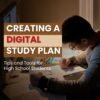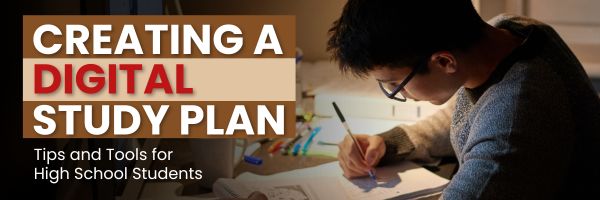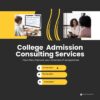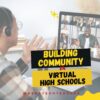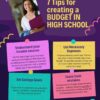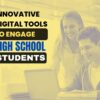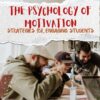Category: High School
ASVAB or a Service Academy? You Decide.
If you want to join the military, you can do that by attending a four-year Service Academy or by enlisting. I discussed 11 ways to become a Navy Officer in an earlier article (click for link). Here, I’ll focus on the academics required to be accepted as an enlisted soldier or sailor.
Anyone interested in a non-four-year-degree entry into the military services must take the ASVAB– the Armed Services Vocational Aptitude Battery (ASVAB). It’s multiple choice test administered by United States Military Entrance Processing Command prior to enlistment. Areas of competence include: (more…)
Share this:
Creating A Digital Study Plan: Tips And Tools for High School Students
With school back, let’s talk about the most efficient ways to study. Here are a few tips from the Ask a Tech Teacher team for High School students who want to get the most out of these important years:
Creating A Digital Study Plan: Tips And Tools for High School Students
Developing a digital study plan can be a game-changer for high school students aiming to improve their academic performance. With increasing coursework and extracurricular activities, a structured approach to studying helps manage time effectively, reduces stress, and boosts learning outcomes.
Thanks to the many types of digital tools available, creating a personalized study plan that suits your needs is easier than ever. By utilizing these tools, you can organize your schedule, set clear goals, and track your progress seamlessly, ensuring you stay on top of your studies.
According to research conducted at Stanford University, over 70% of high school students report feeling stressed about their academic workload. A well-structured digital study plan can help alleviate this stress by providing a clear path to manage assignments, study sessions, and personal time. In the following sections, we’ll explore how high school students can use digital tools to enhance their study habits and academic success.
Leveraging Digital Tools For Efficiency
For high school students, leveraging digital tools is essential to managing the demanding balance of academics, extracurriculars, and social life. Digital calendars, such as Google Calendar or Microsoft Outlook, are invaluable for scheduling study sessions and setting reminders for important deadlines. These tools provide a visual representation of your study plan, making it easier to adjust and stay on track.
Numerous online resources exist where you can find lecture notes, study guides, and other helpful materials. For example, you could find a selection of study material at Studocu that you can utilize. These resources can complement your study plan and provide additional support. Cloud storage solutions enable you to access your study materials from anywhere, making it easier to study on the go. Organizing your digital files into folders by subject or topic can further streamline your study process and ensure you can quickly find the materials you need.
Organizing Your Digital Study Resources
Effective organization of digital study resources is crucial for high school students striving to maintain a smooth and productive study routine. With multiple subjects and various types of assignments to manage, keeping your digital materials well-organized can significantly reduce stress and save time.
Start by creating a dedicated folder for each subject on your device or cloud storage platform. Within these folders, further categorize materials by topics, chapters, or types of content (e.g., homework, lecture notes, practice tests). This systematic approach allows you to quickly locate the resources you need when studying or completing assignments.
Tagging files with keywords related to specific topics or concepts can also streamline the process of finding materials. For example, if you’re studying for a biology exam, tagging relevant documents with terms like “photosynthesis” or “cell division” can help you quickly retrieve the information you need.
Regularly updating and decluttering your digital folders ensures that your study materials remain relevant and useful. Backup your files frequently to avoid losing important documents. Keeping lecture notes, study guides, and other resources well-organized saves time and reduces the frustration of searching for materials during study sessions. A well-maintained digital library enhances productivity and allows you to focus more on learning and less on logistics.
Designing A Flexible Study Schedule
Creating a flexible study schedule is essential for high school students who need to juggle academic commitments with extracurricular activities, part-time jobs, and social life. A well-structured yet adaptable schedule helps ensure that you cover all necessary topics while allowing room for adjustments as needed.
Start by identifying the subjects or topics that require the most attention. High school students often have a mix of core subjects, such as math, science, and English, along with electives or advanced placement (AP) courses. Prioritizing subjects based on difficulty or upcoming deadlines can help you allocate your study time more effectively. For example, if you have a math test coming up, you might dedicate more time to reviewing formulas and practicing problems in the days leading up to the exam.
Once you’ve identified your priorities, use a digital calendar or scheduling app to create a study timetable. Tools like Google Calendar or My Study Life are popular among high school students for their user-friendly interfaces and customization options. These apps allow you to block out time for each subject, set reminders for upcoming exams and assignments, and visualize your weekly schedule.
Tracking Progress And Adjusting Plans
Regularly tracking your progress is crucial for high school students aiming to meet their academic goals. Monitoring your performance allows you to see what’s working and identify areas that may need improvement. By using digital tools to track your progress, you can ensure that your study plan remains effective and aligned with your objective.
Start by setting specific, measurable goals for each subject. For example, if you’re working on improving your grade in history, you might set a goal to raise your exam score by 10% over the next month. Breaking down larger goals into smaller milestones can make them more manageable and give you a sense of accomplishment as you achieve each one.
Digital tools like Grade Calculator or My Study Life can help you track your grades and monitor your progress in real-time. These tools allow you to input your assignment scores and exam results, providing an up-to-date overview of your academic performance.
A study conducted in Prince William County, Virginia, provides insights into how individual students can benefit from tracking their own academic progress. Middle school social studies teacher Erin Merrill implemented a system where students use a data notebook to track their mastery of specific standards.
This approach aligns with standards-based grading, where students are assessed based on their understanding of clearly defined learning targets. Students can visualize their progress by marking whether they failed, passed, or mastered each standard, and by recording their scores on charts.
The results of implementing this system were positive. Merrill reported a 100% pass rate on the Standards of Learning (SOL) assessments after introducing the data notebooks. Students expressed that they felt more prepared for standardized tests and appreciated the ability to see their progress. This method not only improved test scores but also empowered students to take ownership of their learning, fostering independence and self-advocacy
Engaging With Study Groups And Online Communities
Engaging with study groups and online communities can be incredibly beneficial for high school students. Collaborative studying allows you to share resources, discuss challenging topics, and gain different perspectives. Online platforms offer forums to connect with peers, seek help, and share study materials.
According to a study on student use of out-of-class study groups in an introductory biology course, there were no significant differences in exam scores between students who participated in study groups and those who did not. For example, on exam 1, students who used a study group scored an average of 77.0% ± 7.6, while those who did not use a study group scored 79.2% ± 9.5. Similarly, on exam 3, study group participants scored 80.3% ± 12.3 compared to 80.5% ± 7.4 for non-participants.
When engaging with study groups, set clear goals and guidelines to ensure productive sessions. Online communities can also offer a sense of camaraderie, reducing feelings of isolation, especially during intense study periods. Effective collaboration and interaction with others can enhance your understanding and make studying more enjoyable and less solitary.
Maintaining Motivation And Managing Stress
Maintaining motivation and managing stress are key components of a successful study plan for high school students. Setting short-term rewards for achieving study goals can keep you motivated. Regularly reminding yourself of the long-term benefits of your studies can also boost your motivation.
Incorporate relaxation techniques into your routine to manage stress. Mindfulness, deep breathing exercises, and regular physical activity can help maintain mental well-being. Digital tools and apps focused on mental health can offer guided relaxation sessions and stress management tips. Balancing study and self-care ensures you remain focused, motivated, and capable of handling academic pressures.
Balancing study with self-care is essential for maintaining long-term motivation and managing stress. By taking care of your mental and physical health, you’ll be better equipped to handle the challenges of high school and achieve your academic goals.
Here’s the sign-up link if the image above doesn’t work:
https://forms.aweber.com/form/07/1910174607.htm
“The content presented in this blog are the result of creative imagination and not intended for use, reproduction, or incorporation into any artificial intelligence training or machine learning systems without prior written consent from the author.”
Jacqui Murray has been teaching K-18 technology for 30 years. She is the editor/author of over a hundred tech ed resources including a K-12 technology curriculum, K-8 keyboard curriculum, K-8 Digital Citizenship curriculum. She is an adjunct professor in tech ed, Master Teacher, webmaster for four blogs, freelance journalist on tech ed topics, contributor to NEA Today, and author of the tech thrillers, To Hunt a Sub and Twenty-four Days. You can find her resources at Structured Learning.
Share this:
How College Admission Consulting Services Improve Your Chances Of Acceptance
How College Admission Consulting Services Improve Your Chances Of Acceptance
Navigating the complex college admissions process can be challenging for students and their families, especially for first-timers. With increasing competition, particularly for spots at prestigious institutions, the stakes are higher than ever.
For this reason, college admissions consulting services have emerged as essential resources, providing expert guidance to help students maximize their chances of acceptance. Continue reading to learn more about how these services can significantly improve your college application journey.
Understanding College Consulting
College consulting refers to professional guidance provided by experts, often known as college admissions consultants, to help students process their applications effectively and improve their chances of being accepted. These consultants offer college search assistance, test preparation, essay editing, application submission, and interview preparations. College consulting services are particularly valuable in helping students strategically position themselves to increase their chances of acceptance at their desired colleges.
Typically offered by specialized firms or individual consultants, admissions consultants aim to provide students with a comprehensive plan that aligns with their academic goals, extracurricular activities, interests, and personal strengths. By leveraging insider knowledge and experience, they help students stand out and convince the selection board that they deserve a spot.
The Benefits of College Consulting Services
College consulting services provide a range of benefits that can greatly enhance your college applications. Here are some of them: (more…)
Share this:
8 Crucial Steps for University Admission Success for High School Students
8 Crucial Steps for University Admission Success for High School Students
Applying for university is a significant milestone for high school students. The process can be daunting, but with the right steps, it can lead to a successful admission. Here are eight crucial steps to help high school students navigate the university admission process effectively.
1. Start Early and Stay Organized
One of the most important steps in the university admission process is to start early and stay organized. Begin by researching universities and their requirements during your junior year. Create a timeline that includes important dates such as application deadlines, standardized test dates, and scholarship deadlines.
Tip: Use tools like spreadsheets or apps to keep track of your progress. Staying organized can help reduce stress and ensure you don’t miss any critical deadlines. (more…)
Share this:
Building Community in Virtual High Schools
In response to the challenges of COVID, a dissatisfaction with local in-person schools, and increasingly diverse needs of the high school student population, enrollment in US virtual schools is now over 300,000 with about 20% of students taking at least one online course. There are pros and cons of attending class via computer. You can learn on your own schedule, but what if you have connectivity issues? You have more independence in your learning, but what if the teacher isn’t inspirational?
One big issue among many is the importance of building community in virtual schools. The Ask a Tech Teacher team dug into this:
Building Community in Virtual High Schools
As educators, we often hear concerns about the lack of socialization in online learning environments. However, the reality of virtual high schools is far from the isolated, impersonal experience many imagine. In fact, with intentional effort and innovative approaches, an online high school can foster vibrant, supportive communities that rival those of traditional brick-and-mortar institutions.
The Importance of Community in Education
A sense of belonging enhances student engagement, improves academic performance, and supports mental health. In virtual settings, where students might otherwise feel disconnected, building community becomes even more critical.
Strategies for fostering student connection include: (more…)
Share this:
21 SAT/ACT Prep Online Resources
Here are popular online resources to prepare for ACT and SAT tests (click for updated list):
- Albert Online — lots of SAT practice exams, including subject areas.
- College Board
- Kaplan Test Prep
- Khan Academy reading-writing-practice
- Mindsnacks SAT Vocabulary–a big part of succeeding on the SAT essay is knowing the right word
- Number2.com–for SAT, ACT, GRE
- Perfect Score Project--to prepare for SATs
- Prep Factory–for SATs, ACTs, other
- Quizlet–hundreds of SAT vocabulary prep flashcards
- UWorld SAT Prep
- Veritas Prep–free and fee tips, videos and more
SAT Exams
Here are some that specialize in SAT exams:
Share this:
Harley Wade from State of Writing created 7 Tips for Creating a Budget in High School
It’s graduation time for High School seniors, that moment when they take over their own bills, budgets, and balancing income with outcomes. The Ask a Tech Teacher crew has some great times from Harley Wade on that subject:
Harley Wade from State of Writing created 7 Tips for Creating a Budget in High School
High school is the best time to start learning responsible financial management. If you get a grip on your financial literacy early, you will be able to handle your money more efficiently throughout your life. Financial literacy is defined as the ability to understand how to use financial tools, including personal financial management, budgeting, and investing. The following seven tips by Harley Wade from State of Writing will help high school students learn how to budget properly.
1. Understand Your Income Sources
The first step is figuring out how much money you’re bringing in. What does your parent(s) give you for allowance? How much money do you make from a job or a weekly babysitting or lawn mowing gig? Whenever you have a source of income, it’s good to know exactly how much you’re getting each month. This puts a strict limit on what you have to spend and what you realistically expect to save. (more…)
Share this:
5 Innovative Tech Projects for High Schoolers
Great end-of-year projects for high school students, from the Ask a Tech Teacher team:
5 Innovative Tech Projects for High Schoolers
Project-based learning has gained significant popularity in recent times. Emerging as a creative and insightful way for youngsters to learn and practically implement their knowledge, the idea of project-based learning has been encouraged and applauded by teachers worldwide. In fact, students who make use of this technique tend to retain content 22% better than traditional learning.
Many middle and high schools have started incorporating project work into their curriculum, enabling students to learn concepts faster and apply them to real-world scenarios. However, this shift often perplexes students when choosing the perfect project options. Let’s explore a few options. (more…)
Share this:
12 Innovative Digital Tools to Engage High School Students
High School students will soon move into college and career where digital tools are de rigeur. Knowing the most innovative is a great first step. Here are twelve recommended by the Ask a Tech Teacher team:
12 Innovative Digital Tools to Engage High School Students
In the ever-evolving landscape of education, keeping students engaged can be a challenge. Thankfully, technological advancements have led to the development of digital tools designed specifically to captivate high school student’s attention and enhance their learning experiences.
From virtual reality field trips to interactive quizzing platforms, these 12 tools offer diverse ways to bring lessons to life.
Let’s explore how each tool can transform the classroom environment and spark a love for learning in every student. (more…)
Share this:
The psychology of motivation: Strategies for engaging students
The psychology of motivation: Strategies for engaging students
Motivation plays a role not only in people’s choice to get involved in their goals but also in their behavior, persistence, and, ultimately, success. It is imperative for educators to be aware of the essence of motivation in education in order to create a stimulating environment where students can learn and develop. Through understanding motivation, educators will discover various sophisticated techniques to attract attention and instill a love for learning among students for life.
What does motivation entail?
Motivation is a phenomenon built on the idea of the action of inside and outside factors that together influence an individual to act in the achievement of his/her aims. Experts in psychology have comprehensively analyzed motivation. As a result, they have presented different theories and components which shape the way humans behave. A learner can be driven by two major types of motivation, the extrinsic and intrinsic types, each with its unique characteristics and ramifications on the learning process. (more…)



